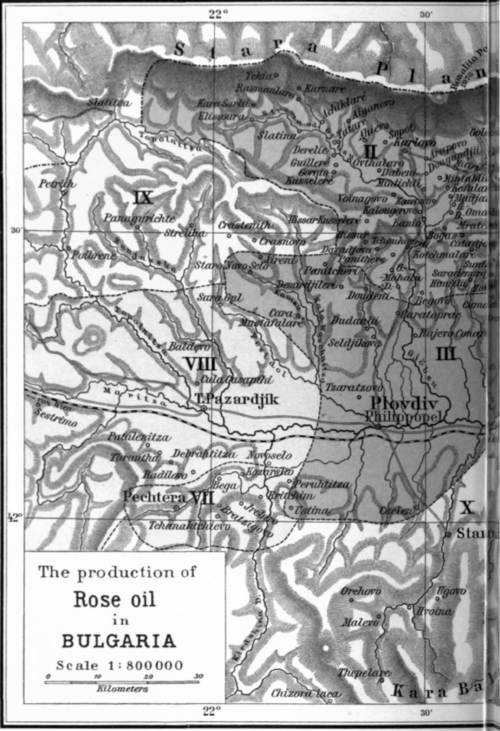344. Oil Of Rose
Description
This section is from the book "The Volatile Oils Vol2", by E. Gildemeister. Also available from Amazon: The Volatile Oils.
344. Oil Of Rose
Oleum Rosarum. - Otto of Rose. - Attar of Rose. - Rosenol. Essence de Rose.
Origin. Only a few of the more than 7000 horticultural varieties of the rose are used in the production of the oil. So far as the roses used for distillation are concerned, it is less a matter of shape and appearance than of resistance to climatic conditions and a rich yield of flowers. Both conditions are satisfied by the Rosa damascena, Mill, cultivated in the Balkan states and in Germany. This cultural variety is not known in the wild state but is a product of horticulture. Presumably the original plant was a hybrid between Rosa gallica and Rosa canina.
The Bulgarian rose bush is fairly well protected by thorns which curve only slightly backward. They bear pointed-oval three-pair leaflets and the end leaflets are of pure green colour; the calices are bare and slightly covered with a white „bloom". Numerous inflorescences contain as many as 21 florets that are arranged somewhat like a false umbel. Completely blown and expanded, the roses do not acquire a diameter of more than 7 cm. Although double, they still reveal a considerable number of antheridia with large yellow anthers. Frequently the outer petals are almost white, the inner ones more and more red, revealing under favorable conditions, a pure rose-red.
1) Journ. de Pharm. et Chim. VI. 18(1903), 369; 21 (1905), 481. - Compt. rend. 140 (1905), 870.
2) Chem. Zentralbl. 1903, I. 1137.

Fig. 40. Rose harvest in Bulgaria.
Fig. 47.

Rose harvest in Bulgaria.
In Bulgaria the roses are cultivated in dense hedges of the height of a man. The white rose, Rosa alba, L., is used to indicate the limits of the several rose fields. It is said to yield an inferior oil richer in stearoptenel).
The rose cultivated in southern France, primarily for the production of rose water and rose pomade, is the Rosa centi-folia, L.2). It is planted in rows but the hedges are not as dense nor as high as those of Bulgaria.
Recently, experiments have been made in the vicinity of Grasse with two rose varieties which possess the advantage of a longer flowering period and of greater productivity. The Rose a Parfum de l'Hay has been obtained by Jules Graveraux in Fontenay-aux-Roses (Seine) by crossing the Japanese Rosa rugosa, Thb. with a bastard of the Rosa damascena and the remontant rose, the General-Jacqueminot, whereas the Roseraie de l'Hay is a similar variety produced by Cochet-Cochet in Coubert (Seine-et-Marne).
The first variety has not come up to the expectations held in Grasse, since the odor of the products obtained therefrom is neither delicate nor strong enough. The experiments with the Roseraie de l'Hay have not yet been concluded3).
Under favorable weather conditions about 3 million kg. of roses are annually harvested and utilized in southern France.
1) Hence the Chamber of Commerce of Philippopolis has recommended to the cultivators of roses not to raise any white roses, since •they afford a poorer yield as well as an oil of inferior quality. Report of Schimmel & Co. October 1906, 65.
2) According to Cochet-Cochet the oil rose of southern France is not Rosa centifolia, L but likewise Rosa damascena, Mill. Berichte von Roure-Bertrand Fils October 1911, 70.
3) Berichte von Roure-Bertrand Fils October 1911, 73.


Between 1904 and 1911 the price paid for 1 kg. of fresh roses varied between 25 centimes and 2.50 fr.1). In recent years a large part of the harvest is subjected to extraction with volatile solvents (Comp. vol. I, p. 251). The yield of concrete oil amounts to from 0,17 to 0,25 p. c.
Spain also has begun to cultivate roses, e.g. in Chinchilla (province of Granada), thus far however, on a small scale only.
Concerning the rose cultures started in Kachetia, Government of Tiflis, in the Caucasus, by the Russian government2), nothing more has been heard in recent years. In 19023) the amount of rose oil obtained amounted to about 3 kg., in addition to 320 kg. of rose water. 11,5 ha. (= 29 acres) had been cultivated with Bulgarian roses. In other parts of the Trans-caucasus, experiments have been made to cultivate roses of Persian origin4).
What variety of rose was cultivated in the rose gardens in Shiraz, formerly so famous, is not definitely known. Possibly it was the Rosa gallica, the dried petals of which are to-day exported from Persia in large quantities. Whether roses are distilled in Persia at the present time is not known. According to a consular report, about 2,5 kg. of rose oil were exported from Jesd, a Persian city, about the middle of the nineties. It has been suspected that this was not a rose oil but an oil distilled together with sandalwood5).
In recent years an Anatolian oil of rose has repeatedly been met with in the market. However, it has been impossible to learn anything more about it. Brussa, Sparta and Burdur in Asia Minor are mentioned as places of production. Neither has it been possible to ascertain whether and to what extent oil of rose is distilled in Damascus and in Marrakesh, Morocco6).
In India where the distillation of rose oil has been carried on for about two centuries in Kanauj (Kanouj)7), in Gazipour on the Ganges and in other parts of Bengal, Rosa damascena is likewise used. However, the oil from these places is never pure but always mixed with sandalwood oil. As already mentioned, sandalwood is commonly distilled together with the roses. All of these places of production play but a very minor role in the world's commerce of rose oil and need receive but little consideration beside Bulgaria.
Continue to:


